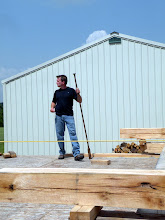My wife is a second grade school teacher of which I look up to with the utmost respect. She has such patience with her students on a daily basis. I like to think I have lots of patience when it comes to teaching chairs but then I realize my few students really enjoy woodworking and we have fun as we make a chair. I guess if I had a room full of 8 year olds who really didn't want to be there then my patience would be tested. I did test my patience to finish fitting all 45 spindles for this settee. After a while you can get into a rhythm. I guess I passed the test.
Here is my set-up to ride the horse and fit each spindle to its own hole in the arm. I taper the arm holes to match the spindle. No glue on this joint just a wedged fit.I cannot emphasize enough about being organized here. I like to use a sharpie and number each spindle on the bottom as I finish it. I pencil numbers underneath the arm as well as the seat holes.
Here you can see I have laid out all the spindles in order, warm water, warmed hide glue, brush and a hammer. These spindles are fresh out of the kiln. Ready for glue-up.
I move at a steady pace and glue each spindle in its corresponding permanent home. No reason to rush but I realize my dry spindles are soaking up the humidity as I go. Some spindles have taken on some crazy bent shapes but no problem with this style settee
Next goes on the arm which I only glue the short spindles and arm post. This is where I hope there are no thick spindles I forgot. All went well.
Then I weave the back through the spindles and drill the back. Some last final checks of the 3/8'' spindle diameter and the arm is tapped down in place. Lots of wedges here.
The shop as seen this afternoon after the glue-up. All I have to do now is carve a crest rail and of coarse about 4 days of painting. More patience! Stay tune for the last settee installment later this week(hopefully)
Here is Larry after completing his rocker last week. Not bad for his first chair. Great job Larry.











































